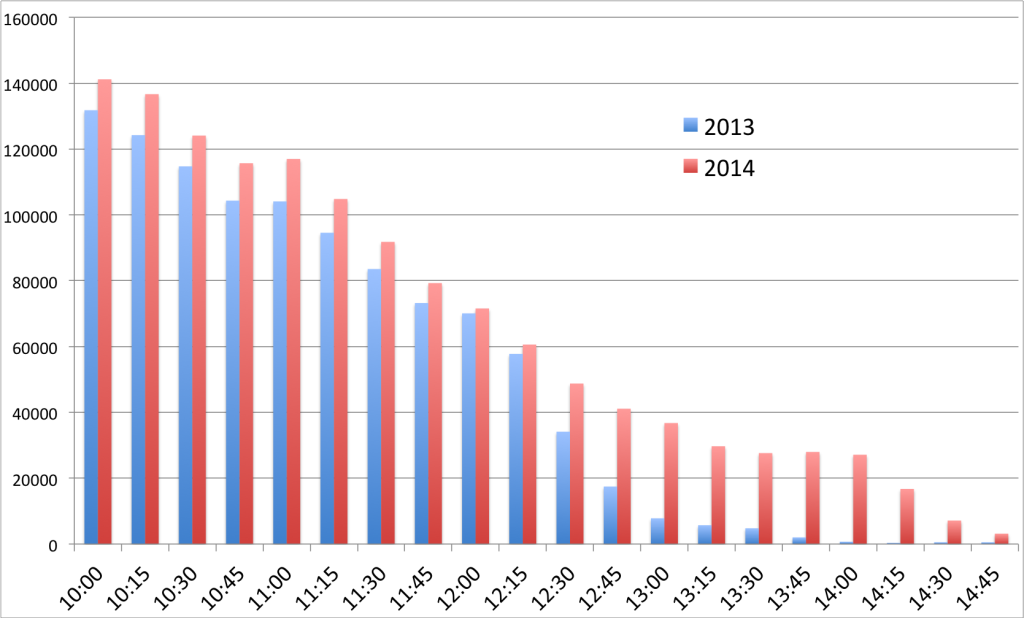It seems simple, right? If there are more riders late at night, they have to get where they’re going somehow, and they’re probably taking the train (or the bus) there. But when you talk about the total cost of the system, it is important to remember that additional late night riders are also traveling earlier in the day, and adding to the total number of trips induced by the late night service.
As of August 6, the system had seen 400,000 late night rides—just shy of 20,000 per weekend, or 10,000 per night. This is 5 times the initial ridership on the 2001 to 2005-era Night Owl buses, which dwindled down to under 1000 by the time the program was scrapped. The cost of the program is pegged in the vicinity of $20 million per year, so the cost for each ride is $10, quite pricey, as the T’s overall cost per ride on subways and buses is about $2 (per unlinked trip; and with monthly passes and reduced fares, the average fare paid is far less).
But the $10 per trip doesn’t tell the entire story. This is because many of the additional rides brought on by late night T service actually occur well before the T would normally stop running. From the data we are analyzing, we see a total increase of 276,000 additional rides after 10 p.m. 192,000 of those occur after 12:30 a.m. This means that 84,00—about a third—occur between 10 p.m. and midnight, and certainly some occur before then. In fact, there are probably a number of people who don’t even show up in these data, but take the train rather than driving because they know that if they are out later than expected, they can still get home.
 Every time bin before 12:30 a.m. (and of course the ones after as well) shows an increase, even those around midnight when, prior to late night service, people would be pouring out of bars to catch last train. Assuming that everyone who rides the T late at night makes an outbound trip, we can double the number of rides—and halve the cost. We could go further and assume that many people make multiple extra trips, for instance, leaving home at 7 p.m. to have dinner in Harvard before taking the train downtown for drinks and grabbing a late night train home. If this is a night out they would otherwise have not taken, it adds three trips to the system. And for $6, it’s still cheaper than cab fare.
Every time bin before 12:30 a.m. (and of course the ones after as well) shows an increase, even those around midnight when, prior to late night service, people would be pouring out of bars to catch last train. Assuming that everyone who rides the T late at night makes an outbound trip, we can double the number of rides—and halve the cost. We could go further and assume that many people make multiple extra trips, for instance, leaving home at 7 p.m. to have dinner in Harvard before taking the train downtown for drinks and grabbing a late night train home. If this is a night out they would otherwise have not taken, it adds three trips to the system. And for $6, it’s still cheaper than cab fare.
Thus, this induced demand probably at least doubles the number of trips taken on the T thanks to late night service, but many of them are taken when the T would otherwise be running. The increases are small—usually in the range of 5 to 10 percent—but they are relatively consistent. Taking account of these trips, the total cost per additional ride is more in the $5 range, which is probably closer to the cost of providing a ride on weekends and other off-peak times. (In other news, the T probably makes money running a chock-a-block Red Line train at rush hour—as Charles Yerkes said, “the straphangers pay the dividends”—but the necessary off-peak service drags down the balance sheet. A similar scenario occurred when the 2009 service cuts were proposed; people made the point that even though most commuter trips were at rush hour, the off-peak and evening trains gave them the safety net they needed to get home. Without them, they’d probably drive.
The original Night Owl bus service cost about $8 per ride; with induced demand earlier, it was probably more in the $4 to $5 range, on par with the current service cost. However, the bus service was far inferior to the current service: slower routings, outdoor boarding and transfers, a confusing route network which did not mesh well with the subway system (unlike some cities like Philadelphia which provide late-night buses along transit corridors, few of Boston’s transit lines parallel streets, so buses can’t easily make the same stops). So for the same cost per passenger, full late-night service provides many more rides, and a much better product. And it likely has room to grow: if Boston can cast off some of it’s parochial past, more businesses will cater to late night travelers and revelers, creating a virtuous circle where where more people are out to patronize late night businesses, causing late night transit service to be more successful.
